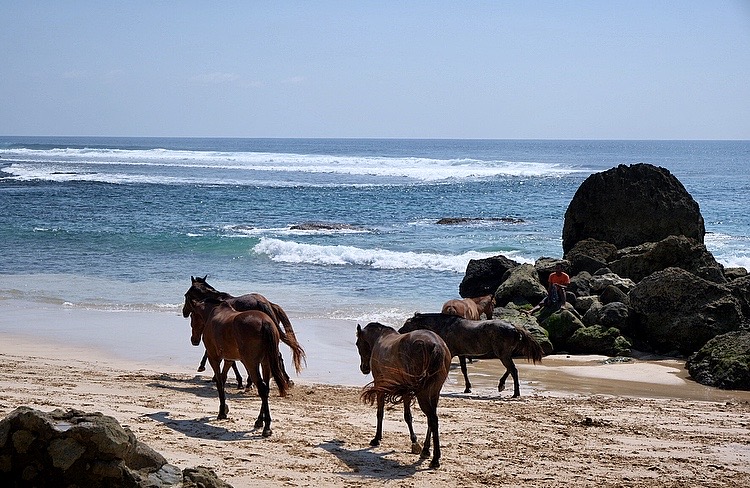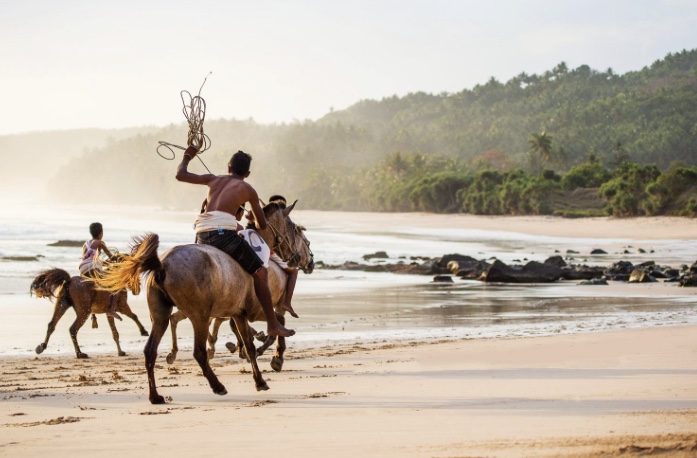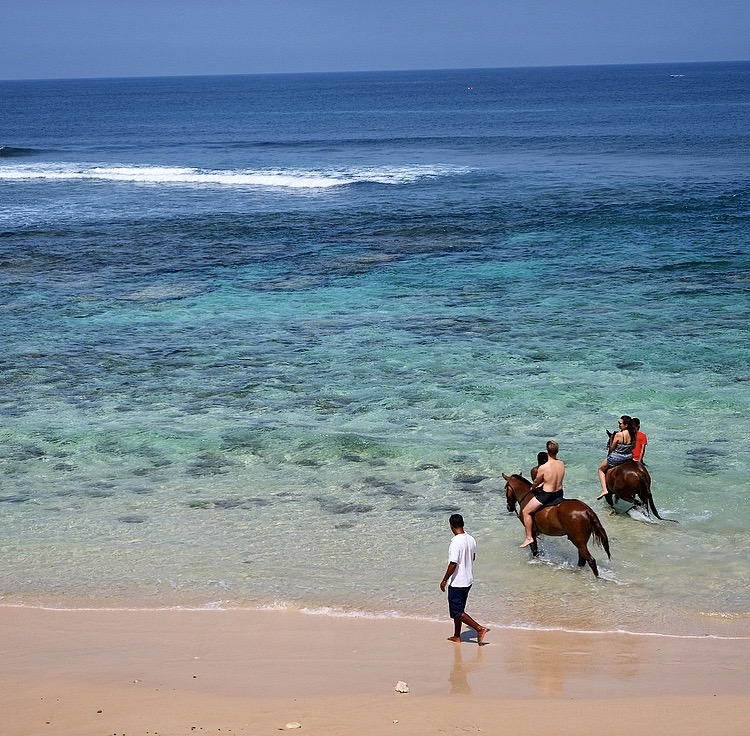Nihi Sumba , Indonesia

The history of the island of Sumba is both fascinating and magical, and gives us a glimpse into an era lost to the rest of the world. The island is breathtaking in its natural beauty and is home to one of the world’s last thriving megalithic cultures, that has remained relatively unchanged throughout the ages.
If you’ve picked up any decent travel magazine or ogled over stunning beach shots on Instagram, then it’s a fair bet that you have heard of Nihi Sumba Resort. With a string of travel awards, including Hideaway of the Year 2019 ( Andrew Harper), Destination 2 World’s Most Instagrammable Hotels 2019, and Travel and Leisure Best Hotel in the World 2016 and 2017. And there are a swag of other awards and accolades as well. In fact, if you haven’t heard of Nihi Sumba, then my guess is, you have been living under a rock!! This is where it’s at!! With a hashtag ‘The Edge of Wildness’ – Nihi Sumba offers guests the opportunity to literally step back in time, whilst relishing in all the luxuries provided by a resort of this caliber.
Flying to Sumba takes approximately one hour from Bali, and comes with pretty basic inflight amenities. To give you some idea, there may not have been air-con on the plane (!!) and the hostess handed out paper bags of bread and water mid-flight!! But this is all part of the adventure that comes with traveling to Nihi.
The resort of Nihi Sumba is a 1.5 hour drive across the island. On arrival at Tambolaka we were met by the amazing Nihi Sumba team, before being settled into an open-top safari-esque style vehicle with a freshly cracked coconut in our hands.
The drive was an eye-opening experience, to say the least! As we passed through small villages and farmlands, the journey gave me the opportunity to ponder a multitude of questions;
- How do these people exist in such poverty?
- And why do so many of them look so happy?
- What were the huge stone structures beside many of the houses?
- How many buffalo would it take for you to be considered successful?
- And why did so many of the houses have such strange shaped rooves?

These and many other questions were answered for me by the charismatic General Manger of Nihi, Julien, over dinner by the beach later that evening. The stories he told were both enchanting and a little bit terrifying in equal measure!
Where were the people of this Island when the rest of society modernised and developed? I like to think they were out tending the rice fields or riding the Sumba horses on the beach,and they simply missed the memo regarding economic development, advances in engineering, healthcare and the likes.
The Story of Sumba
The truth is, not a great deal is known about the Island of Sumba and it’s history, despite its close proximity to Bali. The early Portuguese and Dutch explorers gave the island a wide berth in part because of its reputation as a land of fierce warriors and headhunters, but also because of its lack of spices for trading. Once covered with sweet sandalwood, the island was stripped bare by Arab, Malay, Indian and Chinese traders. This significantly altered the natural landscape making it perfect for breeding cattle and especially for the Sandalwood horses, which were prized by early colonials. Even to this day, the Sumba horse remains the preferred method of island transport.

Magellan described the inhabitants of Sumba in his early records as proud natives clad in fine woven ikats and adorned with beautiful ornaments. Sumba, however was thought to be an island of war and hardship. Rival clans and villages fought often, and beheaded heads were displayed as trophies of battle on ‘skull trees’ in the villages in order to obtain fertile fields and prosperity. Due to this fierce reputation, it wasn’t until the 19th century that the Dutch attempted to settle on Sumba, and even then the soldiers were barely game to venture out of the garrison for fear of losing their heads.
The Sumbanese call their island Tana Humba which means Homeland. Their culture is strongly founded in the belief that the Marapu were the first ancestors to bring civilisation to this homeland, and even today many of their ceremonies and rituals are unchanged from those practiced by their ancestors and they are still highly respected.

The traditional Sumbanese homes have a unique tall peaked roof adorned with small sculptures. According to ancient myths these early homes were covered in human hair taken during head hunting raids. Thankfully now, they are covered with dried palm leaves. The wooden beams on the roof are believed to be the entrance where the spirits can give blessings to their descendants.
The Marapu religion is rich with rituals and ceremonies which are undertaken primarily as a way to ask for the Marapu’s blessing for a harmonious life. Some of these rituals are extremely violent. One such example is where groups of men and boys strap rocks to their hands and fight each other in a huge boxing match. The fighters take these bouts very seriously and strive to draw blood from their opponents. Hunting and killing of wild pigs is also still practiced by the villagers who dress in black loin cloths and ride horses with dogs to hunt wild boars.
The most spectacular ritual, however, is the Pasola, where a full scale war between two opposing tribes is held once a year at the beginning of harvest. The warriors dress in their best ikat cloths and decorate their horses with feathers, then they fight on horseback with spears. Sumbanese tradition dictates that the more blood let on the ground, the more fertile will be the harvest. Chatting with the General Manager Julien I am led to believe that no one has died over the last two years (😳), due to the spears being somewhat blunt at the request of the governing forces. This has led to many complaints from the participants. Just to remind you – this still goes on and it’s 2019!!!! It is held every year in February but the date is never known in advance. Can you imagine being a guest here at the resort at that time!!! Even more concerning is the fact that there has been very little rain over the last two consecutive years. A somewhat disturbing fact!!
The Sumbanese also have strong beliefs and rituals around marriages and funeral rites. Lavish funerals are necessary in their culture, and in the primary burial the body is wrapped in cloths and kept at the house and guarded day and night. This phase can last up to 10 years in some tribes. In the secondary burial the bones are placed in huge stone tombs . Only then do they believe their loved ones soul can be guided to the land of the spirits. A male rooster is sacrificed to wake the spirit when it is placed in the tomb. Buffalos, horses, pigs and dogs are also sacrificed. In the past human sacrifices were also common where a servant or slave would be sacrificed so that they could continue to serve their master in the afterlife.
The rituals around building the stone megalith are also detailed and specific. Ceremonies are held to choose the date for dragging of the stone to build the monument. This date selection also involves the sacrificing of pigs and chickens. (Best not to be born a pig or a chicken on Sumba!!!) The enormous stones are hand hauled over rolled logs, and there is often chanting of sacred songs and sounding of gongs. Funerals can be very expensive and it is Sumbanese belief that the more animals you sacrifice, the more respect is given to the dead. In the past it was not uncommon for noble class families to sacrifice all of their animals only to remain destitute for generations. Now the government is attempting to limit the sacrifices to five animals per funeral, however this decree is often ignored. May I just remind you, this occurs now, still to this day!!
The Sumbanese also have specific rules regarding marriage. If you intend as a man to ask for a girl’s hand in marriage you must give her family more animals than were given to her mother as her dowry when she was married. This can of course mean that many young Sumbanese men are in debt for most of their lives paying off the Buffalo herd they acquired to marry their wife.
Nihi Sumba
The story of Nihi Sumba Resort is linked in many ways to the rich and fascinating tales of the ancestors of this magical island. One such story begins with a man called Claude Graves, who with his wife Petra were the original founders of the resort.

On our first night at Nihi Claude wandered up to the bar at cocktail hour, and over a Bintang or two regaled us with stories of the early days. The whole idea began in 1988 when Claude (a mad keen surfer) fell in love with Sumba and decided to set up camp and build a resort. The initial trek from the airport to the beach took 6 days according to Claude, where they used machetes to literally carve their way through the dense jungle terrain. At that time they didn’t even have water to drink, and had to dig a spring and filter the water repeatedly in buckets. They had Malaria – often!!
Aside from building an incredible resort, having the foresight to control the number of people able to surf the wave, facing earthquakes and far too many bouts of Malaria, Claude was instrumental in founding the Sumba Foundation. From his years in Kenya as a night club owner, a surfer, developer, hotelier and humanitarian – let me just say, it was quite an interesting evening chatting with Claude.
Chris Burch, American financier, and James McBride, South African born hotelier, now co-own Nihi Sumba, purchasing the unique property in 2012. The Sumba Foundation aims to provide clean water, educational programs and Malaria management and prevention within the surrounding villages.
The resort is situated on 567 acres of land on the world famous left break surf beach known colloquially as ‘Occy’s Left’ after Australian surfer Mark Occhilupo. This is a highly coveted private wave and is also often referred to as ‘God’s Left’.

The Rooms
Nihi has 33 Villas which vary in size and style. We stayed in Marangga 4 for the early part of our stay. The room was superb. A stand alone building with a palm leaf covered traditional pitched roof, a private pool, a bale close to the water with a bed where you can sleep the night right on the edge of the ocean, a bathtub to write home about, and stunning jaw-dropping ocean and sunset views from every aspect. It was utterly perfect. Crisp white sheets, a huge carved timber four poster bed swathed in a five metre high canopy of draped white linen. Marangga 4 was a romantic and extremely comfortable room filled with Sumbanese artifacts and beautiful fabrics, which I am guessing were woven in the villages. I absolutely loved it!!

It also had locally produced plunger coffee and hand made coconut dipped in dark chocolate!!! As an added bonus, each villa comes with its own Villa Host. We were blessed to have Simpson who has been at Nihi for 12 years. A fabulously friendly local lad who took charge of all bookings and was able to provide whatever we needed, all with a laid-back style and a cheeky smile.

The Restaurants
There are a bucketload of options for dining at Nihi Sumba. From low-key, surf shack vibes to high end Japanese culinary experiences, you can pretty much tailor your dining choices to your needs. Much of the food is organic and grown locally, fish and lobsters are caught daily and served almost immediately they are pulled from the ocean. The toast is always flame grilled, never toasted. The coffee is produced locally. The food is rustic and authentic and respectful of the origins of this stunning island and it’s people. It is always served with a beaming smile by waiters wearing swords (so probably best not to complain!!!)

The restaurant options on Nihi include the following;
Nil Beach Club & Pool – This is a beach side restaurant with sandy floors and spectacular views. Serving lunch and dinner including fresh sashimi and poke bowls literally on the beach.
The Boat House – This is a small laid back bar nestled beside the surf shop. It’s super relaxed with a cool vibe and soft beats. A perfect spot for a cold Bintang and a beach bonfire.
Ombak – This is the main restaurant and bar, suspended over the ocean and serving stunning breakfasts and beautiful dinners.
Kaboku – This is a 6 seat restaurant at a single bar serving superb high end Japanese food. It is a set seven course menu prepared by qualified sushi chefs. Delicious.
Private Dining – Your villa host can set up a private dining experience at any number of beautiful spots around the resort. We ate in the bale one evening, just above the waves. The Nihi chefs barbequed freshly caught lobster and we ate it under floating flowers and lanterns. An amazing experience.

The Spa
Nihi has a small spa at the main resort where I had a divine organic facial right on the edge of the ocean. Sublime!!
However, the main spa is called NihiOka and is approx 15 minutes by car. Without question the spa safari is a must during your stay. It begins early with a 90 minute hike through villages and rice fields. If you’re in full sloth mode you can easily skip this part and travel by car. On the way you are able to stop and visit a traditional Sumbanese village and experience a small local market. This is truly awesome – don’t miss it. I learnt so much about the local people and it was incredible to wander between their houses amongst the pigs and chickens milling around our feet.

The next step is your arrival at NihiOka spa which is perched on a hill top with sweeping views over the rice fields, lush green grass and the stunning expanse of private coastline. After swimming, breakfast is served in a Robinson crusoe style tree house cantilevered over the water. Then it’s up to your private pavillion overlooking the ocean for your choice of heavenly spa treatments . I think I literally floated home. Simply stunning.

Stepping Out
If you’re thinking you may be bored staying at a beach resort, think again!!! The options at Nihi Sumba are extensive. You can literally lounge around and relax or engage in any number of activities and adventures including the following ;

- Horse riding & swimming with horses
- Surfing
- Fishing
- Paddle boarding
- Kayaking
- Yoga
- Local Community Tours & markets
- Trekking
- Exploring the Blue Waterfall
- Snorkeling
- Cooking
- Weaving……. and the list goes on. Prior to our arrival the resort sent through access to an app that allowed us to plan and pre-book some of these activities. I thought this was a fantastic idea.
Getting There
Sumba is a one hour flight East of Bali. The closest airport is Tambolaka. The resort can book your flights from Bali and will happily arrange airport meet and greet services as well as transfer from the airport to Nihi. If you are keen to hire a car, the resort have a number of open top four wheel drives available for hire, as the roads on Sumba are not always suitable for a normal vehicle.
What To Pack
You can literally pack as much or as little as you like. This is bare foot luxury. Think boho chic with ripped denim shorts, a shell anklet and tousled mane. Swimmers, sunscreen, a hat and a good read are a must! If you’re a keen horse rider, throw in some leggings – the hotel have boots, riding helmets etc. I’d also be sure to pack walking gear and joggers for Trekking and yoga kit ( the yoga mats are provided). The vibe in the restaurants is comfortable and relaxed. Think floaty cotton dresses with a chic head band. If you’re a mad surfer you can bring your own board or use one of the many housed down near the bar.

The Wrap Up
Nihi Sumba is a luxury resort with a conscience offering community outreach programs, a turtle hatchery, and a foundation with the primary aim of providing clean water and Malaria treatment and prevention for the colourful and fascinating local people of Sumba. Much of the produce served at Nihi is grown on the island in the resorts organic garden. This is sustainable eco-luxury nestled on one of the worlds most coveted surf breaks on an island that time literally forgot. Nihi is not slick or modern and it’s not trying to be one of the big name five star hotels. And this, without question, is it’s greatest asset. Smiling faces, and a laid back vibe that literally make you feel like you have been wrapped in a warm embrace and welcomed home.
If Nihi Sumba isn’t already on your hit list, then it needs to be. This is more than just a Hotel – it’s an experience, a new way of living and connecting with something far bigger than yourself.
